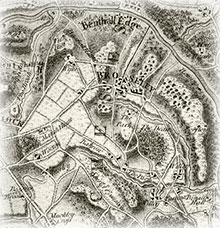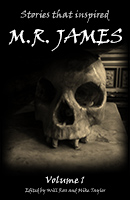 This episode it is the turn of ‘A Neighbour’s Landmark‘ by M.R. James to receive the critial going-over it deserves at the hands of Will and Mike.
This episode it is the turn of ‘A Neighbour’s Landmark‘ by M.R. James to receive the critial going-over it deserves at the hands of Will and Mike.
Thanks to Kirsty for the excellent readings!
Show notes:
- ‘”They’ve got him! In the trees!” M.R. James and Sylvan Dread’ by Steve Duffy (Ghosts & Scholars)
- ‘So jarred were all my nerves’ : supernatural shock and traumatic terror in the ghost stories of M.R. James by Ralph Harrington (artificialhorizon.org)
- A close reading of M.R. James’ “A Neighbour’s Landmark.” by Tychy (tychy.wordpress.com)
- Myles Birket Foster and M.R. James (suptales.blogspot.co.uk)
- The interesting career of Lady Theodosia Ivy (roy25booth.blogspot.co.uk)
- The Lady Ivy’s Trial (in ‘Cobbett’s state trials’ – GoogleBooks)
- Possible locations: Betton Wood, Shropshire | Betton Strange Hall, Shropshire (Monty’s World)
- Glenfinlas; or, Lord Ronald’s Coronach by Sir Walter Scott (allpoetry.com)
- Warnings to the Curious, Ed. Rosemary Pardoe & S.T. Joshi (amazon.co.uk)
Contains the essays by Jacquline Simpson and Brian Cowlishaw mentioned in this episode.
Podcast: Play in new window | Download
Subscribe: RSS
Tags: A Neighbour's Landmark, Betton Wood, Cobett's state Trials, Denmark, Ghost Stories, Glanfinlas, Horror, Judge Jeffreys, Kirsty, Lady Ivie, Lady Theodosia Ivy, M.R. James, Montague Rhodes James, Shrieking Ghost, Weird Fiction








I agree about the narrator’s mental state when he hears the scream: this story and “John Humphries” are, I think, the only places where MRJ describes such an emotional state, rather than confining himself to the usual ghostly horrors.
A small point – that the obscure impulse to keep turning left might be a memory of what is supposed to be the way to get out of a maze.
A second (smaller) point: that from what MRJ says about some of the other State Trials, I wish they were also available.
I like the connection you make between the turning left and a maze, great idea! Though at this point in the story the narrator is rather getting himself into trouble rather than out of it!
This story started great – I love the little comment about people and books at the beginning. But I feel this isn’t a particularly good story. Great set up, but no real wollop. It’s too far removed, it’s just hearing about a thing rather than…well, experiencing it.
Now, seeing as we are coming a little close to the end of the series of James’ stories, have you’s thought of doing The Five Jars, James’ story for children? It’s fiction and it’s James.
Also, seeing as Will has started releasing samples of music on Soundcloud, would there ever be a chance for a soundtrack to the podcast?
Of course I’m a complete idiot and didn’t comprehend the narrator DID experience the screamer.
And the description of what the Mother saw the one time she looked back is pretty great.
Yes to both your questions! We are going to do all the fictional work of M.R. James that we can lay our hands on, also some of his translation work and the parts of his non-fiction that lend themselves to podcast analysis. Once we have finished scraping that particular barrel we will be moving on to James’s influences.
A soundtrack is on the cards, although I’m struggling to find the time to work on it at the moment. As soon as I finish working on the various 1-minute musical snippets for one episode it is time to start on those for the next episode! And we have the M.R. James Quiz app which we’re still working on, not enough hours in the day!
I’d be interested in hearing what you guys make of JS LeFanu, in particular — once the end of the MR James material is reached, and I’m done sulking.
I’d be very interested in a soundtrack too when it comes around. Your music is marvelous.
Not moving landmarks is in the Bible as well.
Deuteronomy 19:14 “Thou shalt not remove thy neighbour’s landmark, which they of old time have set.”
Deuteronomy 27:17 we read, “Cursed be he that removeth his neighbour’s landmark.”
Proverbs 22:28 “Remove not the ancient landmark, which thy fathers have set.”
Yes… I confess I find this one a bit weak, rather ringing the changes on the John Humphreys fragment – right down to that excellent description of the sudden moment of despair. Still, a good show.
Even if the endings don’t tie up in some of James work, this show is just so Awesome. Really, I love all of your shows so pleased that each one gets more enjoyable to escape into
I’m going to stand up for ‘A Neighbour’s Landmark’ as I’ve always really liked it. The descriptions of the landscape and the encounter with the ghost are quite brilliant – and there’s something very odd and memorable about the idea of the ghost going round and around the hill.
And it’s got creepy woods/shrubbery, which James is very good at.
It may lack the ‘Jamesian wallop’ of other stories, but I think it’s more coherent than some of the weaker ones. It’s a story that creeps up to you, breathes coldly down your neck and slips away again.
I’m with Rich on this one.
The descriptive manner of MRJ is brilliant; how the warm glow of an evenings sun turns to the thought of spiders webs and dusty barns is fantastically evocative.
Does every story need a whallop? Or was this the story MRJ tried to write which was just spooky. I thought the chaos of the ghost the effect on the village over hundreds of years were enough.
I really recommend listening to the story when read by David Collings; he truly brings this story to life. Maybe this is a rare example a MRJ story which is best heard rather than read.
I agree with Rich and Delbert both but insist that there is a wallop: the mother’s description of the thing coming on very fast all in tatters with the two arms out in front of it is fantastically creepy. Imagine that in a deepening dusk among trees and you have to jump a fence to get away (in a dress). It’s a great wallop, just oddly placed in the narrative.
I’m not sure it even lacks the ‘wallop’ entirely; I always found the description of how the landscape changes its aspect in the aftermath of the scream to be one of his most graphic moments – ‘dusty beams and creeping spiders and savage owls up in the tower, and forgotten graves and their ugly contents below’. It’s long been a favourite of mine just for that moment; the idea that the sound of a ghost can have the power to cast the whole world into shadow, if only for a while and only in one’s own mind, strikes me as very, well, haunting. It’s a more diffuse kind of haunting than in, say, ‘Count Magnus’, but I found it none the worse for that. It’s less ghost-as-attacker and more ghost-as-contaminant, and that has a creepiness all its own.
It’s something that I rather like about James, actually, that the ghosts he deploys have a wide range of impacts. The ghost in ‘Count Magnus’ or ‘The Stalls of Barchester Cathedral’ leaves the protagonist a mutilated corpse; the ghost in ‘Oh Whistle…’ leaves him alive but profoundly traumatised; the ghost in ‘The Mezzotint’ or ‘A Neighbour’s Landmark’ leaves him troubled but not personally affected – and not knowing which you’d get must have given his original listeners a certain heightened sense of suspense, because the depth of the horror itself was unpredictable.
To me, it adds a sense of freshness and variety, and when looking at the stories as a body, creates the sense of a more plausibly haunted world: not all ghosts are alike, and more than than, not all ghosts can be glimpsed from the same distance. It’s as if we were looking at the work of a wildlife photographer: sometimes he gets right up close to the subject, right into the experience of the victim himself, and sometimes he has to capture it from a greater distance, through the ghost-story-within-a-ghost-story narratives like ‘The Mezzotint’ and ‘The Haunted Doll’s House’ and this one here. Or perhaps, we might say, that like a good academic he was aware of the phenomenon of primary and secondary sources, and sometimes, like here, a secondary source in the form of a ghostly echo is as close as we’re going to get … but in its way, that adds greater verisimilitude, because sometimes that’s how we get information in the real world. Sometimes having to see the ghost only second-hand makes it seem all the more real, like a blurred film image can add to the impact of a special effect.
So yeah, I like ‘A Neighbour’s Landmark’. 🙂
And look forward to hearing you talk about James’s influences too. You know, if you ever decide to look at adaptations of him, I’d like to cast a vote: Ringu, the best Jamesian-story-that-isn’t-actually-James ever committed to film. Credit to my husband for this one, but it’s all there, from the academic investigation of forbidden knowledge, to the fatal object that fixes upon those who see it, to the gathering of dread as the ghost closes in on you in its own inexorable time, to the final wallop as the hair-smeared, white-knuckled crawling horror drags its broken body across to its victim. A very Jamesian aesthetic, both in monster and in structure! (Same way that the best Lovecraft-that-isn’t-Lovecraft movie is probably Alien, but that’s another story, and also my husband’s idea.)
Okay, Kit, you’ve swayed me on this story! Ghost as contaminant is a damn fine description of the whole thing, I quite like that. I always only liked it for the idea of the screaming thing going up and down the path, but you’ve added another layer to it I love.
Fair play to you, BUT I’m not sure if Ring is particularly Jamesian, although I know that you mean. But, to your husband, the most Lovecraftian film is probably John Carpenter’s The Thing – Antarctica, unknown alien horror, fear of the unknown (In the Mouth of Madness not withstanding, but that’s just a giant, semi-Derlethian homage). Alien seems to be more haunted house/slasher than Lovecraftian to me, but it has cinemas best ever monster, until James Cameron ruined it.
Turning left. Very possibly a ref. to Jas 30: 21 (AV)
‘And thine ears shall hear a word behind thee, saying, This is the way, walk ye in it,
when ye turn to the right hand, and when ye turn to the left.’
But is there a resonance with the children of Israel, borders, highways, trespass and Mt Hor? I must look again at exact wording. Book of Numbers and Deut. I think.
The point I meant about ‘Alien’ is that it’s *tonally and aesthetically* Lovecraftian – by which I mean that it has what Husband calls the same sense of ‘aesthetic shock’. Lovecraft was a highly imaginative writer but he was not, bless him, much of a stylist, and very often he reads as if he’s struggling to express a vision that he lacks the language to convey. You can enjoy Lovecraft on a camp level because his fevered narration can have an element of unintentional comedy, but it feels like the comedy of a writer whose head was filled with bigger pictures than his pen could encompass; that’s very different from the knowing black comedy of Carpenter. (Though I agree, Carpenter seems to have a take on Lovecraft too.)
So the alien doesn’t look exactly Lovecraftian – it seems to come out of a different set of visual phobias and fascinations, more to do with insects than sea creatures – but by bringing Giger on board, they managed to create, as you say, one of cinema’s best monsters … and it’s so good because it’s genuinely frightening to look at, a disturbing combination of absolute otherness and a weirdly insinuating echo of humanity as well. Isn’t that Lovecraft’s monsters? Both absolutely alien to us and frighteningly involved with us?
Structurally, no, the film is not very Lovecraftian, but then structure wasn’t what made Lovecraft distinctive. (Nor, frankly, was it his strong suit, and few films would benefit from following him there.) He stood out because he was trying to convey a different *kind* of horror, the horror not of the ghost or the demon but of the cosmic aesthetic shock. For which reason, I’d say that Alien is, like Ringu for James, close to the spirit of Lovecraft if not the letter. Ringu moves from academia to journalism but preserves James’s pace, his handling of dread and something of the texture of his ghosts; Alien mirrors little of Lovecraft’s storytelling or his specific textures, but it creates a visual rendering of the kind of mind-freezing strangeness and utter hostility that his fevered prose was panting to express.
I wouldn’t assume that either Nakata or Scott were deliberately riffing on the original authors; it’s more that they seem to have touched on certain wellsprings that James and Lovecraft also drank from. More a sense of artistic kinship than deliberate adaptation, but artistic kinships often produce more interesting results than direct copies.
Gentlemen, do tell me if this is getting too off topic, and I shall desist. 🙂
I actually have to disagree with you about Lovecraft. Have you read The Colour out of Space? That is a genuinely unsettling story, the only one of his that every spooked me. It’s by far his most ‘weird’ of tales, with the perfect avatar of the unknown that he inserted into everything we wrote. The Temple is also a great tale with some very creepy stmosphere. But what you have to remember about Lovecraft is that it isn’t what wrote that was so revolutionary, it was what he implied. The fact that he took horror out of the supernatural and replaced gods and demons with alien creatures just hadn’t been done, even Algernon Blackwood’s The Willows (Lovecraft’s favourite tale) still had veneer of the supernatural about it. He did write some funnier stuff, though, like the little known ‘Ibid’ and ‘Sweet Ermengard’, and The Hound is very much a self parody – it’s over top and super Gothic and genuine fun to read.
I actually wrote a paper on the xenomorph for college, funnily enough. It’s perfect – humanoid, but not human, black like the shadows it moves in, bigger than you, mindless, moves like an insect but looks more like a human skeleton, it’s atavistic tail trait makes it animalistic and the best part is it’s facelessness, because when you start taking away normal traits from humanoids, it starts really bugging people. It’s just a huge mouth with its monstrous, elongated (symbolic) head. It’s the perfect monster in every sense of the word. And you’re actually quite right about HPLs monsters, because he had a strain of themes about ‘you are the monsters’, like !!!SPOILER!!! Arthur Jermyn, Rats in the Walls and Shadow over Innsmouth. Although there’s just as many that aren’t, it’s more about us just not getting what these are in the first place.
You know what, that does make sense, so fair play. There is that sense of genuine unknown about it, the real fear of it, it’s omnipresence, cunning and power. But the thing that makes it un-Lovecraftian is the fact they kill the creature, that’s mortal and defeatable. There were rarely any kinds of victory for HPL protagonists, save for maybe !!!SPOILER!!! The Shunned House and Dunwich Horror.
You’re probably right about that, but Giger was a Lovecraft fan, his first released book of art was called Necronomicon. Scott did pretty much rip off At the Mountains of Madness for Prometheus, too.
I think it’s fun, but this is why I think we should have a little forum for the podcast!
“You know you’re old when you can’t get out of a chair without letting out a sigh”…. I suppose that would have been Billy Connolly. To be rather more specific: he talked about making these “involuntary noises” on the final episode of Parkinson.
Keep going, guys, I enjoy your podcasts very much. Time for another episode, methinks.
Greetings from The Netherlands!
Thanks Frank – we have another one in the works, will be up *real soon now*. You know your Parkinson!
My pleasure – personally I like to think I know my Connolly instead (who is aka Big Bill Connolly, the man who put “….” in “country ‘n’ western”).
I wonder if this will get past moderation, even with the dots! Just for good measure, let us have a few more….
Toward the end of Pfaff’s biography, there’s a footnote about the reference to the Times Literary Supplement at the start of this story. Pfaff gives the date on which the article appears – 11 August 1921. But the notes to this story by Joshi (Penguin) and Cox (Oxford World’s Classics) both describe the reference as fictitious. If anyone has access, via a library, to the TLS archive, it might just be worth checking this.
I agree with Rich & Delbert, I have always loved this story. There is something very scary about being alone in a wood and having the feeling that it is haunted or that you are being watched (as I know from personal experience), so this story for me is one of my favourites.
I, too, love this story. It was one of the first I ever came across – via Michael Horden’s reading of it, and it’s still my favourite.
Maybe I’ve missed something – but the only thing I can find which links the events of the story to Theodosia Ivy is the reference by one of the locals to TI having also been known as Bryan. Maybe, as you suggest, this fraud was a sort of rehearsal for her later career; but the crime is very different. The summary of the court case, given in one of the links you provide, doesn’t mention any orphans.
The tenuous connection is odd, and reminds me of the oddly irrelevant quotation from Dickens at the start of “Rats”.
When I first read that the narrator was constantly drawn to the left, I could only think of the word “sinister,” which comes from the Latin word for “left.” As if the narrator is walking into a more and more sinister situation.
I also thought of Count Magnus when the narrator didn’t want to stick around for the third scream. Count Magnus, you will recall, had to be called on three times to be released from his grave (just like Beetlejuice!). James seems to believe that evil comes in threes.
Or! What if the screams were actually the two children whose land was stolen? They never received justice, so they too haunt the area?
Guys, if it makes you feel better, my sisters and I have often been asked if we’re English because we say ‘aunt’ with the ah instead of the more usual American pronunciation ‘ant’. Also, there are leftovers of meal names here where supper and dinner confuse and mingle depending on family habit. Supper is a late lunch-ish meal, dinner the last meal of the day but farm families often switched where the heaviest meal was, while not changing what they called it by time. It’s regional.
This story has always been one of my favorites both for the lovely scene painting of his first view and the marvelous use of accents and characters, but also that fantastic spooky ghost, seen only once. Then it ties up with a crisp short explanation based on history but without being tedious.
PS have I been misreading it all this time? I thought “that which walks in Betton wood knows why it walks, or why it cries.” IE it does know but no one else knows. I read over the article by Tychy and remember your remarks in the podcast but honestly always saw this as ‘no one knows why it does what it does except itself.’
Just listened to a reading of this on the internet. Never one of my M R James favourites, on reflection, I have to admit that it is a cracking little story. The descriptions of the landscape and what it is that inhabits the site of Betton Wood are very well drawn. So too the reference to the savage owls and the falling of dusk over the countryside – “the sun was down behind the hill, and the light was off the fields …”
A few thoughts…. First, a minor one. We have a species of scrub oak here in Massachusetts (USA). It typically grows on poor soil, such as in sand near the shore and on the tops of bare, bedrock hills. It never grows very tall, and the gnarly branchs seem to grow every which way, and grows in dense thickets – like what you might expect in a haunted landscape, perhaps.
Regarding the gentleman’s comment on Victorians, I’d point to Lytton Strachey’s 1919 book Eminent Victorians, which was much celebrated at the time as a take-down of the pompous, hypocritical scoundrels who had been much admired in their time. The book has since been described – fairly, I think – as a hatchet-job. It appealed to the ‘we are oh so superior’ crowd of the time, and I can well imagine how a man like James would not have appreciated it. Indeed, you don’t have to be a reactionary to agree with him, at least in part.
I believe there was a reference to perambulation in the podcast. The state of Massachusetts long required a perambulation of the city to find the stone landmarks that defined the borders of the city and the surrounding towns. Sadly, the law was changed, and men in bowlers no longer hike through muck to find the stones. The following link leads to maps and photographs recording the 1896 perambulation. https://www.flickr.com/photos/cityofbostonarchives/sets/72157632485566123/
Finally, one of the podcast hosts asked whether the gentleman in the story still gave money to the village like his father did. He couldn’t, because he didn’t know the story until he got the papers out and read his father’s story.
To me, this story just didn’t work. If you hear a terrible screech – twice – you don’t just go about your business. His (almost) indifference made no sense. And at the end I felt like I just dropped into a hole. It wasn’t quite ‘and then he woke up,’ but it had a similar jarring feeling to it. There’s some very good writing here, just not a well worked out story to me.
“Torn to flinders” is how the damage to Stephen Elliott’s nightshirt was described in “Lost Hearts” as well.
In the weird fiction collection ‘Den lange drømmen: fortellinger fra grenseland’ (‘The long dream: tales from the borderland’) from 1992 by Trond Buland there is a story titled ‘Betton Wood’, and at the end of the story there post script by the author, rendered here in my translation: Betton Wood is located where described in the story, by The Shropshire Union Canal, or The Shroppie, as the canal enthusiasts often call it, a few kilometres north of the village Market Drayton. Folklore says that the wood is haunted by a shrieking ghost.
And Frank Buttler, who maintains the sluice gate at Adderley is famed for his roses. (Many refer to the rose garden by the canal as Adderley Park.)